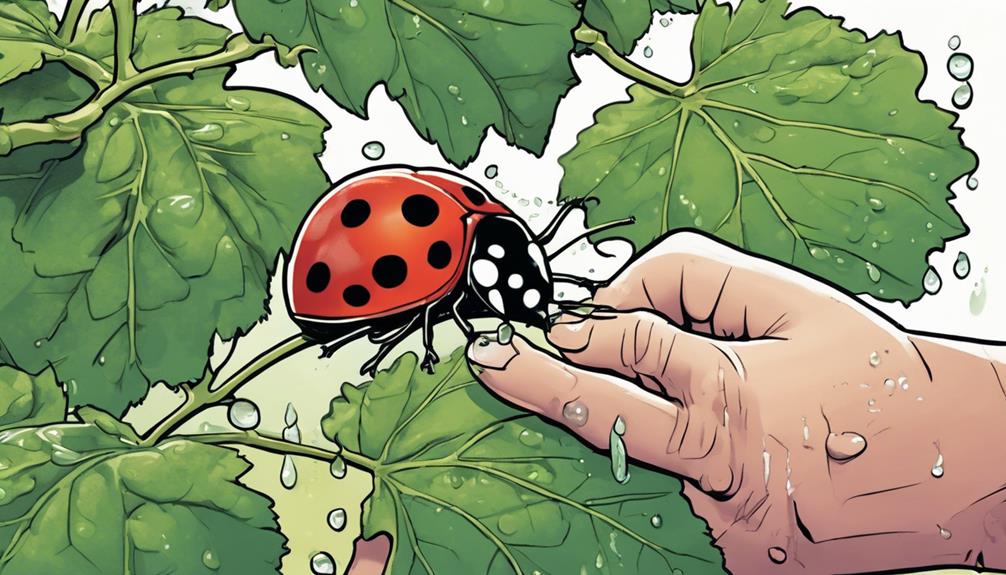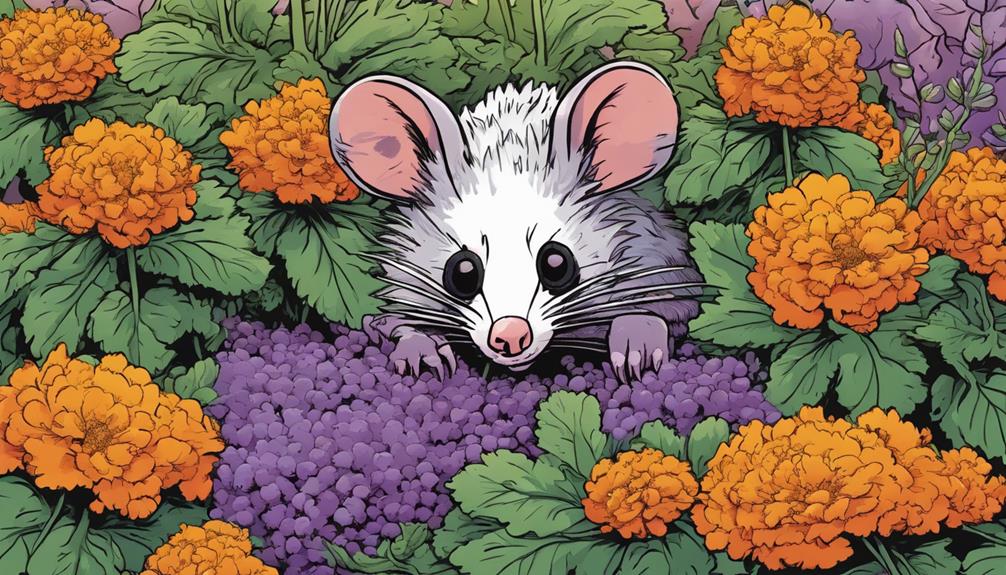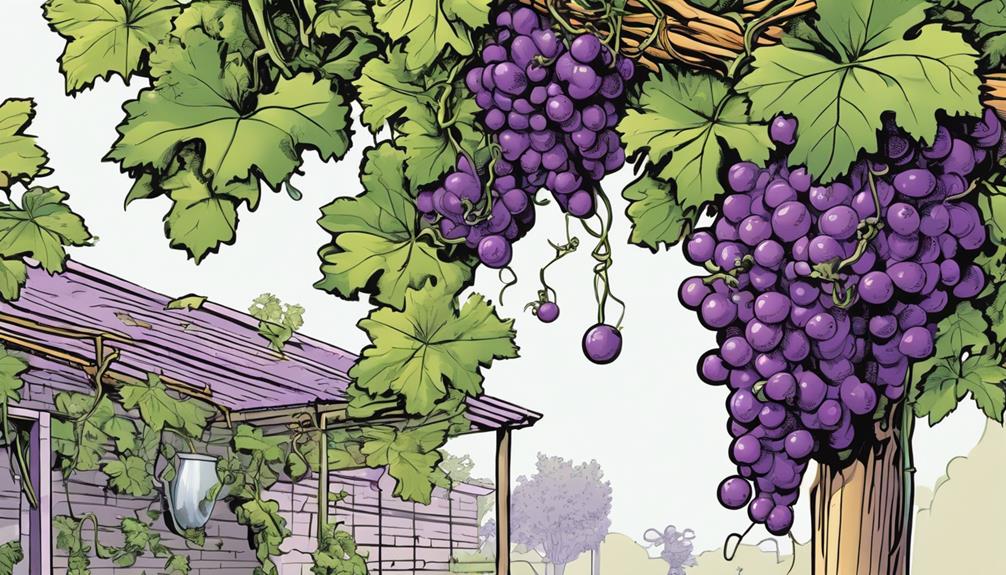Caring for a possum grape plant involves more than just sunlight and soil.
A crucial step often missed is key to its growth.
Discover what many forget in ensuring the health of this plant.
Elderberry and Possum Grapes are misunderstood as same by most of the time. but there are some differnces in these plants. Here is a comparison of those two plants.
Planting

When planting your possum grape vines, it's essential to ponder factors like when to plant them, prepping the holes and trellising for support, the spacing between vines for prime growth, and installing root stock while staking new vines to encourage strong root development.
Ensuring these steps are done correctly sets a solid foundation for your possum grape plants to thrive and bear fruit abundantly. Take the time to plan and execute each planting step carefully to give your vines the best start for a successful growth journey.
When to plant possum grape vines
Plant possum grape vines in late fall to early winter. This helps them grow strong roots before spring.
Plant them in a sunny place with soil that drains well. They do best in zones 10 to 11.
They may need support to climb. Planting at the right time helps them be healthy.
Prepping holes & trellising
To plant possum grape vines, follow these steps for a successful planting:
- Dig holes large enough for the root ball.
- Set up a sturdy trellis at least 6 inches away from the hole for support.
- Place a trellis away from the hole for vine support.
- Guide the vine towards the trellis for climbing.
- Use mulch around the plant and trellis to keep soil moist and reduce weeds.
Spacing between vines
Space Possum-Grape vines 3 feet apart. This helps them grow well and lets air move around. Good space stops vines from being too close, fighting for light and food, and makes looking after them, like cutting and checking for bugs, easier. If they’re too close, they might grow into each other, get less air, and catch more diseases. Keeping them 3 feet apart means healthier vines and better growth.
| Spacing | Benefits |
|---|---|
| 3 feet apart | Good growth and air |
| Stops too close growth | Easier care |
| Less fight for food/light | Healthier vines |
| Fewer diseases | Better growth |
Installing root stock and staking new vines
To grow a healthy possum grape plant, ensure the root stock is strong. Here’s how to do it:
- Pick strong root stock: Choose plants with bright leaves and big roots.
- Support new vines: Use stakes to help the vines grow right.
- Space well: Keep stakes far enough apart so vines don’t get too crowded.
- Help vines climb: Stake in a way that helps vines go up without tangling.
Pruning & Training
When it comes to caring for your possum grape plant, understanding how to prune and train it properly is important.
First-year pruning and training of vines are essential to establish a strong foundation for future growth.
Ongoing annual pruning not only helps maintain the plant’s shape but also encourages best fruit production.
First year pruning and training vines
To help your possum grape plant grow strong and healthy in its first year, follow these steps:
- Prune carefully: Cut off weak or too many vines to help air move and light reach the plant better.
- Train for growth: Make the vines grow up by guiding them onto a trellis or support.
- Shape and prevent tangling: Cut extra growth to shape the plant and stop vines from tangling.
- Set the foundation: Doing regular pruning and training from the start helps your possum grape plant grow well.
Ongoing annual pruning for shape and fruit production
Annual pruning is key for your possum grape plant’s shape and fruit production. Pruning keeps the plant healthy and productive. Focus on cutting off dead or sick branches. This helps the plant stay healthy.
Pruning shapes the plant, improves air flow, and stops overcrowding. Regular pruning lets sunlight reach all parts, helping the plant make more fruit and stay strong. Keep pruning every year for a healthy possum grape plant.
Trimming away suckers and excess growth
Remove suckers from your possum grape plant to keep it healthy and well-shaped. Follow these steps:
- Find Suckers: Look for suckers growing at the plant’s base and remove them quickly.
- Cut Extra Growth: Trim any extra vines or branches to stop overcrowding and improve air flow.
- Shape Plant: Train the vines to grow in the direction you want to make the plant look better.
- Remove Dead Parts: Cut off any dead or damaged areas to help the plant grow new parts and stay healthy.
Pollination & Fertilization
To guarantee successful fruit production, remember that possum grape plants are self-pollinating, negating the need for cross-pollination.
Use a balanced fertilizer with an N-P-K ratio of 10-10-10 during the growing season to support healthy growth. Apply the fertilizer around the base of the plant, avoiding direct contact with the stems or leaves to prevent any potential burning.
Self-pollinating flowers
Caring for your possum grape plants means knowing they’ve self-pollinating flowers, which help them make fruit on their own without needing bees or other pollinators. Here are some simple points about self-pollinating flowers:
- Possum grape plants make fruit on their own. This means you’ll get fruit reliably.
- Plants from self-pollination are very similar to their parent. This leads to less variety in the plants.
- Knowing about self-pollination helps with growing more plants. It’s useful for making more possum grape plants.
- These plants can keep making fruit regularly. Their ability to self-pollinate helps with steady fruit production.
Recommended organic fertilizers and timing
For good growth and more fruits on possum grape plants, use organic fertilizers with a N-P-K ratio of 3-1-2. Put these fertilizers on the plant during its growing time. This helps the plant get what it needs to grow well.
Don’t use too much fertilizer; it can hurt the plant. It’s best to put the fertilizer on the soil or close to the roots. The right time to do this is important.
Feed the plant sometimes, and change how much based on how the plant is doing and the time of year. With the right organic fertilizers and correct timing, your possum grape plant will do well and make tasty fruits.
Keep it balanced for a healthy plant.
Watering & Pest Management

To guarantee your possum grape plant thrives, understand the watering needs specific to your region and adjust the schedule accordingly. By monitoring soil moisture levels regularly and mulching around the plant, you can maintain peak hydration levels for healthy growth.
Additionally, be vigilant in identifying and managing common pests organically to protect your plant from potential damage.
Watering needs and schedule based on region
Watch the Weather: Know your area’s usual weather to decide how often to water.
Use Deep Watering: Give each plant a gallon of water to reach the roots well.
Add Mulch: Putting mulch around your plants keeps moisture in, especially when they’re growing a lot.
Change with the Seasons: Water more in hot times and less when it’s cold.
Keep it simple and your possum grape will do well.
Identifying and controlling common pests organically
To deal with caterpillars on your possum grape plants, use Bt or chili extract. These natural methods protect your plants without bad chemicals.
Also, bringing in beneficial insects or picking caterpillars off by hand helps without harming the environment.
Applying diatomaceous earth on your plants keeps pests away too. Watch for leaf miners, which show as white streaks or spots on leaves. Act early to stop them from harming your possum grape plants.
Stay alert and use these organic ways to keep your plants healthy.
Diseases & Winter Care
To protect your possum grape plant during winter, be wary of fungal diseases like powdery mildew and root rot. Adjust your watering routine to prevent waterlogging and maintain good air circulation around the plant.
Keep an eye out for signs of stress, such as yellowing leaves, and consider moving the plant to a warmer spot if needed.
Preventing and managing diseases
To keep your possum grape plants healthy, it’s important to stop and control diseases like powdery mildew and leaf spots. Here are easy steps to follow:
- Make sure there’s enough air moving around the plants to stop fungal diseases like powdery mildew.
- Use soil that drains well to lower the chance of root rot and other problems caused by too much moisture.
- Take off any leaves that are sick right away to keep leaf spot diseases from spreading.
- Think about using sprays that kill fungi to prevent diseases that usually affect grape plants.
Winter protection methods
In winter, keep your possum grape plant safe from cold air and sudden drops in temperature. It’s vital for the plant’s health and living. Keep the temperature above 50°F to stop cold harm. Look out for signs like wilting or leaves falling because of winter. Use a humidifier to keep the air moist around your possum grape. Do not put the plant close to heaters or vents that might dry it out. Below is a simple table to help you protect your possum grape in winter:
| Winter Protection Methods | Description | Benefits |
|---|---|---|
| Keep Temperature Above 50°F | Keep it warm | Stops cold harm |
| Use Humidifier | Keeps air moist | Fights dry air |
| Watch for Stress Signs | Look for wilting or leaf drop | Helps plant stay healthy |
Harvesting & Storage

When your possum grapes are fully ripe and dark purple, it’s time to start harvesting them in suitable quantities and bunches. Proper storage and preservation methods are essential to make sure your harvest stays fresh for longer periods.
Learn how to maximize the potential of your possum grape harvest for various culinary applications.
When possum grapes reach peak ripeness
When possum grapes are fully ripe, they taste the best and are very sweet. Look for a dark purple or black color on the grapes. They should feel firm. Ripe grapes will come off the stem easily.
Keep the grapes in a cool, dark place to keep them fresh and tasty.
Harvesting quantities and bunches
After checking that possum grapes are fully ripe, carefully pick the right amount of fruit bunches. This keeps the quality high and avoids harming the plant.
Make sure to gently remove the fruit bunches without disturbing the leaves. Only take fruit bunches that are ripe for the best taste. Depending on how many fruit bunches there are, collect several but leave some to keep ripening.
Harvesting the right way keeps the plant healthy and productive. Store the possum grapes properly to keep them fresh for later.
Storing and preserving the harvest
Keep possum grapes fresh in the fridge for up to 1 week. Here’s how to store and preserve them:
- Freeze possum grapes to keep them longer for recipes.
- Make preserves like jams and jellies from possum grapes.
- Dry leaves for herbal teas.
- Use dried leaves for crafts and home decor.
Companion Plantings

When considering companion plantings for your Possum Grape plant, it’s important to choose beneficial ground covers and trellising vines that can enhance its growth and visual appeal.
Ground covers like Tiarella cordifolia can provide a lovely contrast with foamy white flower stalks in early spring, creating a harmonious garden environment.
Trellising vines such as Aquilegia canadensis can add a pop of color with their nodding yellow and red bi-color blooms, complementing the Possum Grape beautifully.
Beneficial ground covers and trellising vines
To help your Possum Grape plant grow well and look nice, you should plant helpful ground covers and climbing vines around it. These plants make your garden look good and help your Possum Grape by giving it support and protection:
- Creeping Jenny is a ground cover that grows low. It has bright green leaves that look great with Possum Grape’s leaves.
- Morning Glory is a vine that climbs. It can grow up with the Possum Grape, making a beautiful tall display.
- Creeping Thyme is a ground cover. When you step on it, it smells nice, which adds a nice touch to your garden.
- Clematis is a vine that you can train to grow with your Possum Grape. It has colorful flowers that bloom at different times.
Regional Differences

In caring for possum grape plants, adjusting your care practices according to your specific growing zone and climate is essential.
Different regions may require varying watering frequencies and protection measures to guarantee ideal plant health.
Understanding these regional differences will help you provide tailored care for your possum grape plant’s growth and well-being.
Adjusting care by growing zones and climate
Adjust your possum grape plant care for different zones and climates by changing how often you water, control temperature, and manage light. Follow these tips to make sure your plant thrives:
- Water more or less depending on your area’s weather to make sure your plant gets the right amount of water.
- Keep plants warm during cold spells by adjusting how you care for them based on local temperatures.
- Place your plant where it gets the best light, considering how much sun different areas get.
- Change your care routine (like how often you water, temperature control, and light) to fit the climate where you’re growing your plant.
Frequently Asked Questions
How Do You Grow Possum Grapes?
To grow possum grapes, make sure they get enough sun and well-draining soil. Water regularly, especially in dry spells. Mulch to retain moisture and deter weeds. Prune dead branches for healthy growth. Fertilize in spring for better blooms. Watch for pests and diseases.
What Is the Possum Grape Vine Used For?
Possum grape vine is used for various purposes. It has been historically utilized for making bow strings and in ceremonies. It is also a popular folk remedy for Type II diabetes and has shown potential in reducing blood sugar, triglycerides, and cholesterol levels.
Are Possum Grapes Safe to Eat?
Possum grapes are not safe to eat as they can cause gastrointestinal discomfort. It’s essential to avoid consuming any part of the plant. Remember, possum grapes are grown primarily for decorative purposes, not for consumption.
What Can You Do With Possum Grapes?
You can use possum grapes for crafting, ceremonial practices, or traditional medicine. They have been explored for treating Type II diabetes and arthritis. Some regions consider them invasive. Harness their potential while being mindful of regulations.
